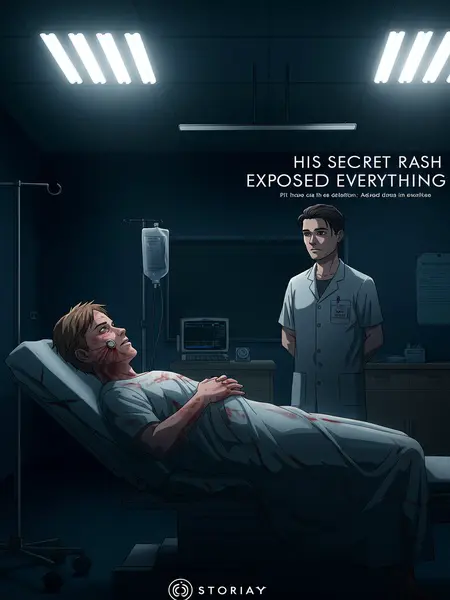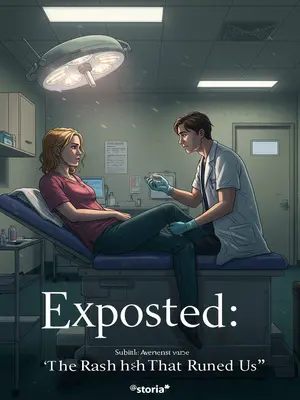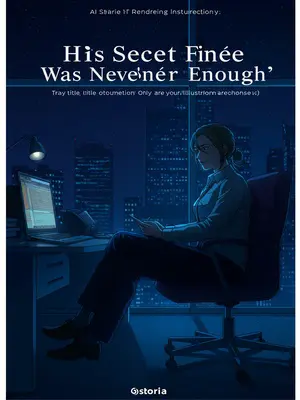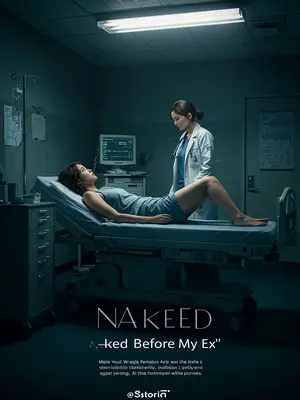Chapter 2: Tension and Tests
She came back juggling the charger and his phone, her face etched with worry. You could see she was trying to keep it together, even as her eyes darted to the rash on his arms.
He put on a casual smile, almost overcompensating. The tension in the room shifted—now it was all about the allergy, nothing more. In small-town ERs, you learn how quickly secrets can turn into background noise when someone else walks in.
She frowned, hugging her coat tighter. The question came out sharper than she probably meant, laced with suspicion. It was the kind of everyday skepticism that keeps doctors on their toes.
He spoke fast, voice tinged with irritation. "If the doc says you need blood, just let him do his job, okay? You’re not the doctor here." She rolled her eyes, a sign they'd had this back-and-forth before.
She still looked very worried. "Drawing blood isn’t good for your health. He’s up half the night on his phone, never eats right, and he just kicked a cold—his immune system’s shot, doc."
I shot her a reassuring smile. I angled my body just enough to block her view of the chart, a silent promise that his secret was safe for now.
Most folks only know the headlines—STD, scandal, something whispered about in health class or gossiped about at family gatherings. The stigma runs deeper than any rash ever could. I kept my tone light, not wanting to add fuel to her anxiety.
I launched into my standard ER spiel, talking about allergy panels, IgE levels, and the importance of knowing your triggers. She seemed to relax a little, grateful for a concrete answer.
He shot me a meaningful look, eyes wide with unspoken gratitude. I gave a slight nod in return, letting him know I hadn’t forgotten his real concern.
I handed them a small blister pack and explained how to take it, making sure to use simple language. The observation room hummed with soft beeps and quiet chatter from other patients waiting out the night. I told them to relax, maybe watch something on his newly charged phone.
The waiting room was starting to fill up with the usual late-night crowd: folks with sprained ankles from the bowling alley, a teenager with a busted lip from a pickup basketball game, and an old man coughing into his handkerchief. A mom balanced a crying toddler on her lap, and the scent of burnt coffee drifted from the nurses’ station. I juggled charts and prescriptions, but kept one eye on the clock for my anxious couple.
The 2 a.m. crowd is always the same—people running from guilt, fear, or just their own imaginations. Sometimes it’s easier to confess your sins to a stranger in scrubs than to your own reflection.
I’ve lost count of the number of folks who walk in convinced they’ve ruined their lives after one bad choice. I always tell them the same thing: our job is to help, not to judge. And most of the time, the only thing they leave with is peace of mind and a small bruise from the blood draw.
By the time I’d seen my fifth stubbed toe and third cold of the night, the anxiety from earlier had faded into the background. The couple was just one more story in a sea of late-night drama.
They shuffled back in, the man looking a little less pale, the woman still fussing over his sleeves. The air in the ER had that stale, 3 a.m. feel—everyone waiting for either bad news or relief.
I clicked through the system, silently cursing the hospital Wi-Fi. Sometimes waiting for lab results feels like watching paint dry. The couple perched on the edge of their seats, anticipation thick in the air.
She leaned in, her voice dropping to a worried whisper. The way she kept glancing at him told me she’d been losing sleep over this, too. In small towns, everyone’s health becomes everyone’s business, whether you like it or not.
I glanced at the clock, running through my mental list of possibilities. A week-long rash was a red flag, and I felt a prickling in my gut—something didn’t add up here. I made a mental note to dig a little deeper.
The gloves snapped on, cool against my hands. I moved slowly, knowing patients often get tense when you start poking around again. The fluorescent lights brought every detail into sharp focus—the fading welts, the newer spots, the old scratch marks. I took my time, not wanting to miss anything.
He sounded almost sheepish, as if long-standing allergies were a personal failing. I reassured him that medication tolerance wasn’t usually the issue. Sometimes, even the best medicine can’t keep up with a stubborn immune system.
I leaned in closer, using a penlight to highlight the affected areas. The transition from angry welts to faded pink spots was textbook in some ways, but I kept my doubts to myself. In the ER, you learn not to jump to conclusions, especially at three in the morning.
He hesitated, scratching at his arm absentmindedly. I watched his face for any sign of discomfort, trying to piece together the puzzle.
He shrugged, as if it were no big deal. But the casualness didn’t quite match the rest of his story. Sometimes the little details are where the truth hides.
I made a mental note, my inner alarm bells ringing louder. Allergic reactions usually play by the rules—this one was coloring outside the lines.













